Subtotal: $
Checkout
Next Article:
Since the year 2000, historic droughts and flooding rains have hit Australia’s farmers hard. Pastures have withered in affected areas, forcing farmers to shoot starving sheep and cattle. Could there be a different way to practice agriculture that helps the land flourish even amidst climate change? Plough’s Chris Voll talked to Johannes Meier, who runs the Danthonia Bruderhof’s farm in New South Wales.
Already a subscriber? Sign in
Try 3 months of unlimited access. Start your FREE TRIAL today. Cancel anytime.
The unique challenges of Australian agriculture
Plough: In May 2019, Danthonia Bruderhof celebrates twenty years since its founding. Tell us about the community’s ongoing discovery of how best to farm this land.
Johannes Meier: In 1999, the Bruderhof purchased two neighboring farms in the Northern Tablelands district of New South Wales, Australia. It’s an area known for its agriculture and is deemed reasonably rain-safe, at least on paper. Two families and a few singles from the United States packed their bags and boarded a Qantas flight – and so began the Danthonia Bruderhof community.
We arrived full of enthusiasm – and inexperience! To help us, for the first year we retained the farm manager from Danthonia’s previous owner before taking on the farm ourselves. Like most farms in this district, Danthonia had run a mixed operation, grazing beef cattle and merino sheep, and cultivating standard crops: grains in winter, beans, sorghum, corn and sunflowers in summer. We continued planting crops for that first year, and it went well. But we then decided to focus just on livestock.
In those beginning years, we discovered the hard way how costly it is to farm, even when the weather cooperates. In addition to keeping the vehicles and implements up and running, there’s the outlay for herbicides, seed, fertilizer, and so forth. The first wool clip from our sheep covered the cost of chemical drenches and shearing, but it was clear the earnings weren’t going to be nearly enough to support the growing community. What’s more, the farm was placing unsustainable demands on our workforce at a time when we were also putting up buildings and finding ways to get involved in our new neighborhood.
So we started a sign-making business to provide an income. That’s developed well, so that we’re now able to support the two hundred twenty people living together in community here.
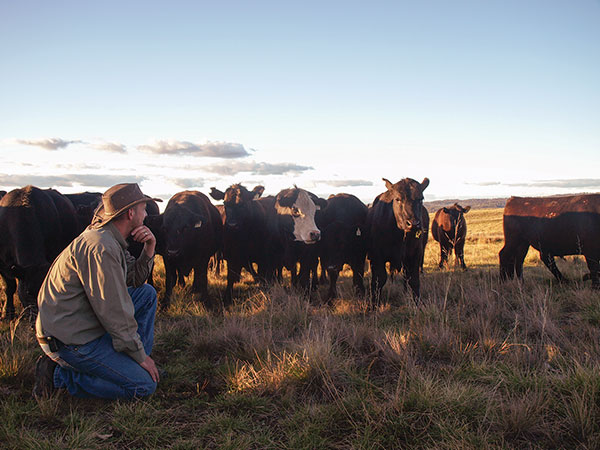
Johannes Meier
Why not just walk away from farming?
The Bruderhof’s way of life has always been linked to the land, going back to early pioneers like Philip Britts. For our first four decades of communal living, farming literally put food on the table; since then, we’ve earned our money mostly from manufacturing. So the establishment of the Danthonia Bruderhof twenty years ago was a chance to connect again with the land. Over time, with adjacent acquisitions, we brought our farming country here to around 5500 acres, of which perhaps half was pasture, a quarter cultivated, and the rest wooded slopes and rough country only marginally suited for grazing.
Still, we weren’t coping. So we scaled back and tried a few common models. We allowed contractors to run their cattle on our property for a fee. For a number of years we leased out the farm. Of course, as we discovered, tenants naturally want to make as much money as possible from the property, often at the expense of the landscape. Within a couple of years, overgrazing had seriously damaged our land.
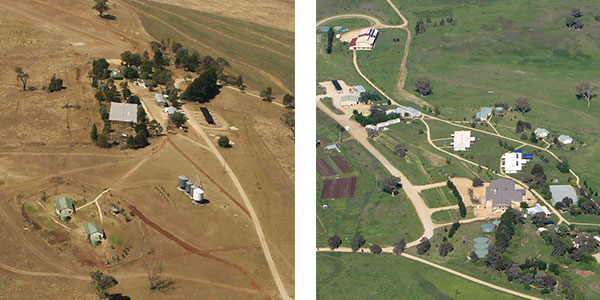
Aerial views of Danthonia in 2000 (left) and 2017 (right) showing the community’s growth in a healing landscape.
My family arrived at Danthonia in November 2004. By then the effects of what would become known as Australia’s Millennium Drought were already painfully obvious. Drought became even more severe, persisting until autumn 2010. The drought caused us to think hard about the way we cared for our landscape. I’d come from England, where rain is often more of a bother than a blessing. So it was extremely strange to find myself constantly looking to the west and watching the clouds every day, month after month, year after year, waiting for the gift of rain. When occasional rain did fall, the land hardly responded – it was in such poor condition.
In 2007, we watched our creek dry up. It’s a beautiful little creek, lined with willows, running through a wide floodplain at the base of Swan Peak, Danthonia’s prominent landmark. I will never forget seeing the drying, algae-glutted pools, with dead fish – golden perch, eel-tailed catfish, and Murray cod, some up to thirty inches long – lying belly-up; the eroded, crumbling banks; no flow whatsoever. In 2009, it happened again, only with no dead fish. They were all gone. I remember thinking, “This isn’t right. What are we doing here?”
So the crucible of drought turned us to an arduous process of discovery: how to bring our landscape back from the brink and restore it to life and health.
The Millennium Drought
Yet was the Millennium Drought really such an exceptional event? Isn’t drought just part of how Australia’s climate has always been?
That’s only partly true. There’s no doubt it’s a rugged environment – you can plan on droughts and floods. Farmers in our region will tell you that for any ten years you can figure on two bumper years, three or four reasonable-to-mediocre years, and three or four total failures.
But now, in addition to Australia’s naturally fickle weather, we’re also contending with climate change: average temperatures have risen markedly since 1950, with an even greater increase in how often we get days with extreme temperatures. That certainly increases the challenge of farming.
It’s crucial to remember we’re part of a much longer story. Australia is home to the world’s most ancient continuous civilization, with the first indigenous Australians thought to have arrived around sixty-five thousand years ago. If you equate that span of time to a single day, then the first European settlers – the First Fleet that entered Botany Bay from England in 1788 – got here less than seven minutes ago.
Some of those Europeans kept excellent diaries or made drawings and paintings of what they found. The country they describe was vibrant and healthy, with natural pastures boasting three to four hundred species of plants. They documented that even when no rain had fallen for three months, the valley systems held lush, fresh grass.
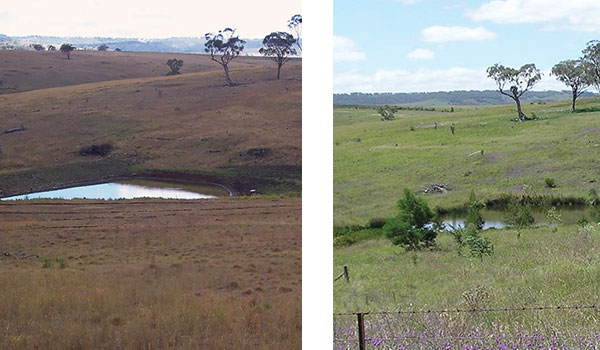
Paddock and dam before and after holisic management: in 2007 (left) and 2015 (right)
Their records clearly show that the fertile zones were not limited to the coastline. They describe a landscape beautifully adapted to benefit from the cyclical climate, with unique functions that enabled it to capture and store water. They described topsoil depths of one to two meters, with cracks deep enough a man could hold a machete and lower it and his entire arm into them, and still not touch the bottom. That soil was so spongy that even during a drought a single wagon’s tracks would remain visible in the pasture sward for years.
The explorers found a landscape that functions very differently than Europe’s, whose large waterways carry superfluous water to the sea. Instead of these, Australia had wide, broad floodplains filled with reeds over a dozen feet high, swamps with occasional pools, and riffles where water moved downhill through the valleys. Some of these riparian systems were twenty-five miles wide and capable of holding immense quantities of water, which was released into the landscape during drought. Others, such as the marshlands along Danthonia’s creek, were narrower, but served that same sponge-like function.
It’s hard to overstress the importance of the plants in these systems. The reeds and other diverse, multi-storied plants managed water for the landscape. Tragically, that was not understood by the first Europeans. They brought their own paradigms: drain the swamps, open up the waterways to boats, bring hard-hooved grazing animals into the valleys, plow the topsoil and plant monoculture crops.
The results were catastrophic. In less than ten generations, Australia has seen massive erosion and desertification brought on by the destruction of functioning riparian areas and by farming practices that disregard the landscape’s natural ability to hold water and keep salts at bay. Today, we’re farming on subsoil, not topsoil. Natural plant and animal diversity is a shadow of what it was. With few plants to help store water in the landscape, slow its movement, spread fertility across flood plains, and control salts, when rainfall comes it washes out to sea, carrying with it untold tons of precious topsoil.
Yet some would say you’re painting far too bleak a picture. Is Australian agriculture really in crisis?
I can only speak from the experience of the farmers here in eastern Australia. As has been widely reported in the media, farmers are really struggling – as a result of the drought, they have little remaining ground cover, livestock are starving, wildfires have increased, and there’s dust blowing everywhere. Many farmers say it’s the worst drought in a hundred years. They’ve had to drastically reduce the number of animals they stock and have been hand-feeding hay and grain for the last one to two years.
This situation spells financial ruin for many. The fact that our government agencies have been giving out hundreds of millions of dollars in emergency aid to farmers indicates the scale of the crisis. And for the individual farmer, the aid offered is often pitifully inadequate.
From what I’ve come to understand from numerous farmers across this country, as well as from the insights of scientists and farmers internationally, there is no doubt in my mind that this is largely the result of conventional farming methods. These have done great damage, especially here in Australia.
Moving beyond conventional agriculture
Still, haven’t the methods of agriculture developed over the past hundred years been hugely effective in growing more food?
It’s true that through mechanization and artificial fertilizers, we massively increased our ability to produce food. On the face of it, this looks like amazing progress – much more food for a lot less labor. But what becomes ever clearer is that industrial agriculture violates the natural ecosystems on which human beings rely. It hurts the landscape, the animals, and us, the consumers. And as we’re seeing here in Australia, at some point it stops working.
Take intensive tillage, for example. Plowing, disking, and harrowing expose soil biology, a vital source of plant nutrients, to the elements. Moisture evaporates, soil erodes, and soil carbon is lost. In our part of the world, our soils are vertisols – heavy, cracking, clay-based soils that are very prone to erosion. In one good thunderstorm, inches of topsoil disappear from tilled ground, as we saw at Danthonia in our early days of Australian farming.
With industrialization came monocultures – huge fields planted with a single crop variety. Every farmer implements crop rotation, but when we ignore the contribution diverse plants make to soil biology through root exudates (more on those later) and load on synthetic fertilizers, which can eliminate root exudates altogether, we’re killing our soil.
After World War I, huge factories that had been cranking out ammonium nitrate for explosives were suddenly shuttered – but not for long, because someone discovered that ammonium nitrate was a wonderful source of nitrogen for plants. Soon they were synthesizing the three primary nutrients for plant growth – nitrogen, phosphorus, and potassium – and ladling this NPK fertilizer onto crops.
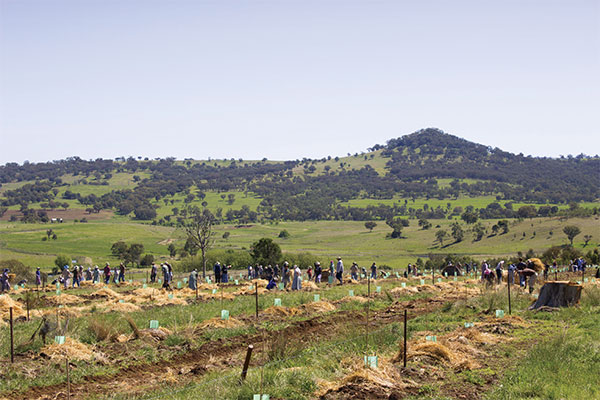
And the plants seemed to love it. They grew higher and yielded larger harvests. But the soil suffered. In a healthy ecosystem, plants live in symbiosis with the soil in an exchange of sugars for nutrients. What we didn’t realize was that by short-circuiting the nutrient cycle through NPK fertilizer, we were cutting off numerous other nutrients and micronutrients that would come into the plant and build a nutrient-dense product. As a result, we now have woefully nutrient-deficient crops. In fact, studies by the research scientist Donald R. Davis suggest we may need to eat far more fruit and vegetables than our grandparents did in order to get the same nutritional benefits. There’s strong evidence linking these dietary deficiencies to our increased health problems.
On top of that is the witch’s brew of chemicals we’ve dumped on our landscape for years, with limited understanding of the toxic effects they have on our ecosystem and on us. Our Western diet has become a delivery system for poisonous chemicals. Glyphosate (the key ingredient in the weed killer Roundup), which is increasingly suspected as a carcinogen, is everywhere from children’s breakfast cereals to German beer, some of which has been found to contain three hundred times the legal limit for drinking water. A 2016 study concluded that 93 percent of Americans have glyphosate in their urine. To what extent are agricultural chemicals contributing to the increase in a wide range of diseases in Western countries – autoimmune disorders, obesity, diabetes, heart disease, infertility, and autism?
Intensive irrigation is another aspect of industrial agriculture that has often proved destructive, especially here. It’s opened farming opportunities in landscapes with inadequate rainfall, yet these areas often have high levels of salt in their groundwater. Over time, through irrigation, salt build-up in the soil has ruined huge swathes of agricultural land. Aquifers can’t keep up with our insatiable need for water, so perennial drought ensues. In Australia, agriculture accounts for 50–70 percent of the nation’s water usage but only 3 percent of GDP. Recently, Australian media have extensively documented the ecological disaster that is the Murray Darling River system, brought on largely by mismanagement of water for agriculture.
The good news, however, is that there is a way back. We can stop destroying and start restoring. We can work with nature so that, in essence, the land heals itself. It is simply a matter of grasping certain principles that must be respected. For us, coming to terms with these key principles was a journey. But we now know there are logical steps to follow.
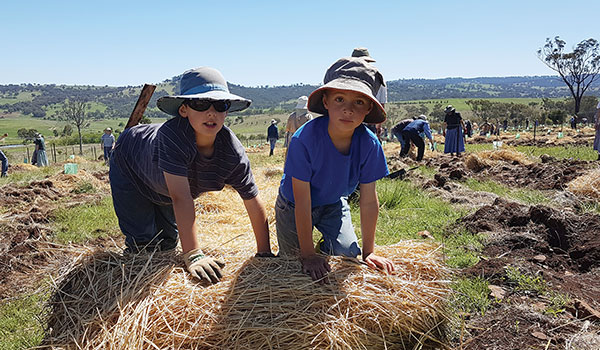
Planting olive trees with young and old
Walk us through how that actually works. Danthonia has similar rainfall to its neighbors, and yet here there’s feed for the cattle and water in the dams, while neighboring farms are parched and the livestock is starving. Why the marked difference?
There’s a multifaceted answer. Let’s start by looking at what makes a landscape healthy.
One indicator of an ecosystem’s health is the ability of its plants to convert sunlight to sugars. These sugars help plants grow and are also fed to the soil, transforming into humus – that amazing substance at the heart of topsoil that holds minerals and resources, as well as four times its own weight in water. Through the plants’ activity, humus and soil organic matter are built up, increasing soil carbon, and the land begins to absorb and hold more moisture. Instead of running off the hillsides to the ocean, rain stays in the landscape.
Scientists calculate that for every percent of soil carbon present, the landscape can hold 140,000 liters of water per hectare (about 15,000 gallons per acre). In Australia, the estimated average soil carbon content pre-European settlement ran from 7–20 percent. It now averages below 1 percent. Imagine if we increased it to 5 percent, which is still below pre-settlement levels: ten acres of land would be capable of holding enough water to overflow an Olympic-size swimming pool.
Understanding this is one thing. But how do we actually bring the landscape back to health? Here at Danthonia, having seen how overgrazing by tenants had damaged our pastures, we knew the answer would involve the way we run cattle. Through that, we learned about the concept of holistic grazing management and its proponent, Allan Savory. He is a Zimbabwean ecologist, environmentalist, and livestock farmer who set out to discover why so-called overgrazing was ravaging the African landscape when herd sizes were at an all-time low. Eventually he struck on the fact that hunting had decimated the predators that historically forced herds to stay tightly bunched for protection. His experiments demonstrated that when cattle were bunched together to mimic traditional herd density, the landscape began to revive.
The wildebeest on the savannahs of Africa or the buffalo on America’s Great Plains did more than just consume and trample grass as they moved in large, tightly bunched herds, harassed around the edges by lions or wolves. Rather, by thoroughly speed-grazing an area and enriching it with their manure before moving on, they provided plants the means to grow to full potential. And we know that those areas were fertile; in the United States, meters of topsoil were built up this way, only to be tilled up and blown away during the Dust Bowl years.
That’s holistic grazing management in a nutshell. Once we understood its basic concepts, we got out our fencing tools and began dividing our large paddocks into smaller ones, where we crowd more cattle for shorter grazing periods. Holistic grazing requires careful planning and recordkeeping and the commitment to move cattle frequently, sometimes daily. In my opinion, it is our most powerful tool to exert landscape change and recovery. That is what regenerative agriculture, as we call it, is all about.
How does that help in combatting the effects of drought?
Around 2006, we came across an Aussie named Peter Andrews, who’s given forty years of his life to understanding how to regenerate the landscape. Peter is a genius for his ability to read landscapes and understand the functions needed to restore them. He developed his ideas into a framework called Natural Sequence Farming.
I visited Peter’s farm in 2007, at the height of the Millennium Drought. He took me first to the neighboring property and showed me the bone-dry creek. Then we walked downstream onto his land. Pretty soon there were pools of water, and floodplains growing green. By the time we reached the end of his property, the creek was a flowing stream. It was astounding: in the middle of a desert-dry landscape was a running creek surrounded by dense trees and shrubs, with abundant animal life. We continued along the creek into the adjoining property. Hardly three hundred meters downstream from Peter’s farm, the bed was dry again. I had never seen such a stark demonstration of the link between the local ecosystem and water in the landscape. It inspired us at Danthonia: if Peter Andrews can do it, why can’t we?
With Peter’s input, we started implementing Natural Sequence Farming. We removed our cattle from riparian zones to allow the creek to heal and to encourage vegetation along its banks and floodplain. In these areas, we planted numerous trees. In times of flood, this plant life helps slow the water and capture nutrients. The goal is to encourage the natural recreation of linked ponds and reed beds, such as were here for millennia.
On the slopes higher up we are working to mimic other once-natural functions, by building level contour banks that retain water from big rains. When the bank overflows, strategic openings allow water to spread slowly so the land can absorb it. Nutrients washed down the slope also spread evenly. Below the bank, we plant trees that utilize those nutrients, provide shade, and contribute to soil biology. In our valley, which drains to the creek, we’re developing a system of ponds and reed beds and planting trees to slow the movement of water.
The community has planted thousands of trees over the past two decades. Why?
So far, we’ve planted around one hundred thousand trees. They bring all kinds of benefits. Trees impede wind as it travels across the landscape; the faster wind moves, the more moisture we lose. Trees provide habitats and shade. Where there are trees, the earth will absorb up to sixty times more rainfall than pastureland. Their roots pull nutrients up from far below the surface – a mature tree deposits 7 percent of its full biomass into the soil every year, which benefits shallower plants. And they are simply beautiful.
We’ve planted trees strategically, often in beltways along ridges. These are a mixture of native and exotic varieties for diversity. We fence them to keep the cattle out. Today, trees we planted fifteen years ago are tall enough that cattle and native wildlife can move among them, enjoying their shade and depositing their dung and urine high in the landscape where the nutrients can do the most good as water moves them downhill.
Bringing back the birds
Have you seen measurable changes yet as a result of the steps you’ve taken?
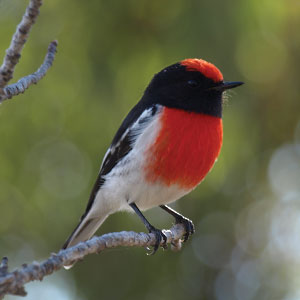
Red-capped robin: since 2006 birdwatchers have seen five to six new species each year, even in dry years.
Definitely! Birds are an early indicator of ecosystem health. When Danthonia’s birdwatchers started counting over a decade ago, we recorded around one hundred bird species; today that number stands at 150 and counting. Of the fifty new arrivals, eleven species are associated with expanded and healthier wetlands and open water, and fifteen with the significant increase in flowering trees and shrubs. The rest relate to species migration and generally improved quality of life.
Three months ago, as a result of the drought, the contour banks dried out. Yet the sward is spongy underfoot, and the grass is green and continues to grow. This underscores that the most effective place to hold water is in the soil. Recently I compared our well water records against our current usage. Despite very poor rainfall, our wells have higher water levels than in bygone droughts. More water is being held in the landscape.
At our creek we’ve found that water enters our property at a flow rate of sixteen liters a minute. Where the creek leaves our farm, water flows at fifty liters a minute. Even during drought, the volume of water we’re passing to our neighbors downstream is three times greater than what we’re starting with! It’s because water is being retained higher up on our land and working downhill over time. This is tremendously encouraging and inspires us to keep working.
You spoke earlier about the incredible loss of topsoil from Australia’s landscape. That soil must have been thousands of years in the making. How can you hope to regenerate it?
Historically, some experts have said it takes three hundred to a thousand years to build inches of topsoil. But we’ve learned that’s actually not the case. Soil is not built primarily by decaying leaf matter and so forth. Living, healthy topsoil is created by plant root exudates – the carbohydrates, vitamins, organic acids, and other nutrients released into the soil by the root systems of plants. Of the sugars that plants create through photosynthesis, 30–40 percent transfers to the soil through the roots in exchange for nutrients. In this way, plants feed soil biology: fungi, bacteria, microorganisms, and mycorrhizae, the symbiotic associations between plants and fungi in the root zone. Those take the sugar and convert it to humus, which is topsoil.
So topsoil can actually be built quite quickly. But it won’t happen without diverse plant life. This diversity is key, and it has everything to do with the way we farm.
It’s a cutting-edge area of scientific research. We’re learning that as plant diversity increases, there’s a certain trigger point – called quorum sensing – where topsoil begins to build rapidly. How many species of plants do you need for a quorum? The more the merrier, microbiologists are saying. Different plants produce different root exudates, allowing access to specific soil nutrients. There have been positive results from as few as twelve species, and more rapid success with forty.
Our best native pastures at Danthonia contain fifteen to twenty species. We’re a long way from the hundreds of species these landscapes once enjoyed – all forming a richly diverse pasture sward that allowed topsoil to build and be maintained, enabling it to hold water and release it during drought. The challenge is is that it’s tough to grow a diverse pasture on poor soil. Spreading compost extract introduces living biology into the soil, but that biology then struggles to survive. So we’re experimenting with a biological stimulant, a cocktail of microbes and organic compounds that feeds and encourages the living elements already in the soil.
One of the reasons we are determined to improve plant life across our property is to combat salinization. In Australia, every rainfall adds salt to the continent: salt isn’t washed out to sea because of the absence of large river systems, so it accumulates, and unless suppressed, it will kill the soil. In bygone times, swampy reed beds and a range of other plants held water in the landscape. This created a subsurface freshwater lens that suppressed the salt and kept it from rising and damaging soil biology. We’re working our way back to that, but we need healthy soil for that to happen.
Already a subscriber? Sign in
Try 3 months of unlimited access. Start your FREE TRIAL today. Cancel anytime.
Where does this leave farmers who rely on crops for their livelihood?
I can’t speak from personal experience, since at Danthonia we got out of cropping a decade ago and converted the land into pasture. But there are promising models of a different way to farm crops. In Western Australia, for example, Ian and Di Haggerty run their farm without chemical inputs. They graze livestock intensively, then sow wheat into those same paddocks and grow it over winter for spring harvesting. Once they’ve harvested the crop, they move the cattle back in. Working with the livestock, they’re able to control weeds without chemical sprays. Their crop yield is less than if they used synthetic fertilizers, but it also costs less to grow, so they’re coming out ahead. At the same time they’re building soil carbon and biology.
Regenerative farming as the way forward
What do you say to conventional farmers who are open to changing but may feel it’s too costly to transition?
Take one step at a time. If you’re into livestock, take steps toward management-intensive grazing. If you’re into cropping, seek out successful regenerative farmers and learn from them. I tell them, too, that the first few years transitioning may be tough, but the results speak for themselves. Cost inputs will go down, nature will begin to heal. The good Lord has designed a natural system that is remarkably able to recover from the worst we’ve thrown at it.
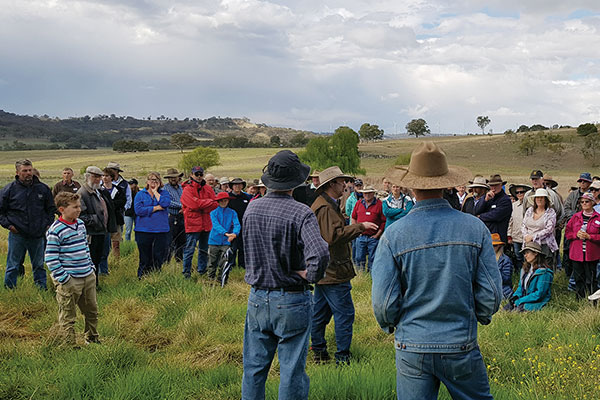
Johannes addressing 300 local farmers gathered at Danthonia in September 2018 for a field day on regenerative agriculture. Also participating was soils ecologist Dr. Christine Jones, whose research into restoring topsoil with plant life has inspired Danthonia’s work over the last decade.
What would you like to see Australia’s government do in support of farmers?
Number one, there has to be buy-in for a regenerative approach, as a matter of urgency. We need to educate officials to convince them to move beyond time-honored but harmful paradigms. Number two, we need government funding to help pay for farmer education and for the upfront costs involved in transitioning to regenerative agriculture: for instance, the fencing required for rotational grazing.
Perhaps the biggest point of contention is water use and the way it’s regulated. Current laws are designed to facilitate moving as much water as possible off the land and into storage areas, from which it can be used for irrigation. That’s counterproductive and needs to change. All of this has to be done responsibly; teamwork among scientists, politicians, bureaucrats, and farmers is essential.
Have you run into opposition to regenerative agriculture?
Sure. Recently I went into our local store and was talking to the agronomist there, whom I’ve known and got along with for years. I said, “I’m no longer going to be using herbicides.” He just turned and walked away. That was the end of the conversation. Whether it’s about money, I can’t say, but he makes his living selling herbicides.
Tim Wright, a farmer down the road from us, has spent twenty-five years regenerating his property. He’s been very successful. Yet despite that, he has neighbors who still ignore him, and he’s the butt of jokes at his local store. We farmers can be a hardheaded bunch – but I like to think that can work in our favor when we put our minds to fixing a problem!
Over time, the Danthonia Bruderhof has earned the trust of the local Aboriginal community. Is there a connection to how you farm?
In Australia, there’s a tradition of beginning public gatherings with a “Welcome to Country”: an indigenous person acknowledges the “traditional custodians” of the land on which the gathering takes place and pays respect to elders past and present. This concept of custodianship – of being caretakers of a landscape, so as to pass it on to future generations in better shape than we inherited it – is one we have tried to embrace. So that is common ground, I believe, with our Aboriginal neighbors.
The truth is, what we’re doing at Danthonia to care for the land is not such a big deal. As thrilled as I am with the steps we’re taking and the way nature is responding, it is only one small part of why we live in community. Our calling is to live a life of discipleship of Christ, and to follow his path as best we are able. Caring for this land is simply a reflection of our desire to be true to Christ who loves the flowers of the field, sparrows, children; who takes pity on the sick and needy; whose heart is with the destitute and downtrodden. This impels our efforts toward fellowship with and understanding of those around us, and particularly with our Aboriginal brothers and sisters. Charles Massy, whose book Call of the Reed Warbler is an absolute must-read for anyone considering regenerative agriculture, says it well: “Not until we attain reconciliation with both the land’s first peoples and the land itself, will we be enabled to ‘arrive’ and truly belong on this continent.”
Regenerative agriculture is ultimately about getting back to the task that God gave Adam and Eve in Genesis 2: to care for the earth that God created as his garden. We have to start humbly, recognizing that we Western consumers are complicit in the global ecological disaster that industrial agriculture has created. Greed and demand drive the markets – and separate us from the way God intended us to live. Agriculture has a lot to answer for, but I truly believe that agriculture has tremendous potential to regenerate our world.
Those of us who farm need empathy for the land and animals; for our neighbor next door; for those starving a world away; for future generations; for everything God created. Our hearts must work as hard as our heads and our hands.
Recently I was reminded of words by the prophet Jeremiah, who lived in desperate times. “This is what the Lord says: ‘Stand at the crossroads and look; ask for the ancient paths, ask where the good way is, and walk in it, and you will find rest for your souls’” (Jer. 6:16).
All that’s required of us is to recognize the crossroads, ask to see the ancient and good way, and then step in that direction.
Interview conducted on January 11 and 17, 2019, at Danthonia Bruderhof in Elsmore, New South Wales, Australia.
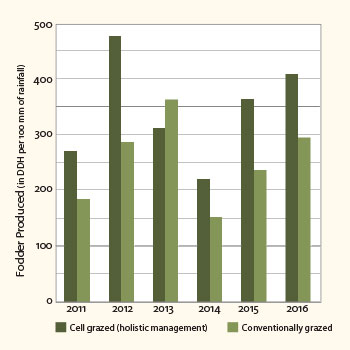
Pasture Productivity
This chart shows the average productivity of four test sites on the Danthonia farm over six years. Each site was divided into two: half was grazed using holistic management, with cattle being moved between smaller paddocks every 1–5 days, while the other half was grazed conventionally. Cell grazing allows plants more time to recover, strengthening root systems, improving soil health, and increasing yield.

Did you know that Plough is published by the Bruderhof, a living community of people seeking to follow Jesus together?
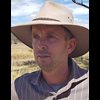
Johannes Meier runs the Danthonia Bruderhof’s farm in Elsmore, New South Wales.
Already a subscriber? Sign in
Try 3 months of unlimited access. Start your FREE TRIAL today. Cancel anytime.






John Carlisle
A most accessible and informative article full of hope and practical endeavour. Surely goodness and beauty will follow them all the days of their lives.
Albert Abel
A great story about a Greater God Who provides and assists and encourages those who commit to Him. May blessings continue to abound